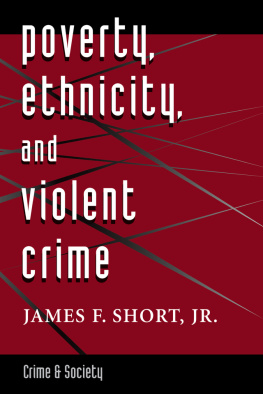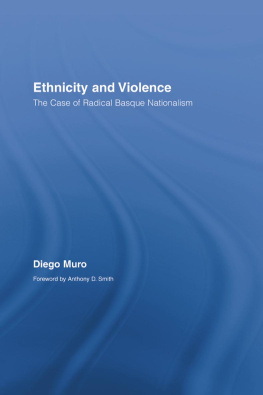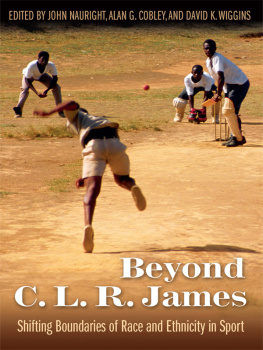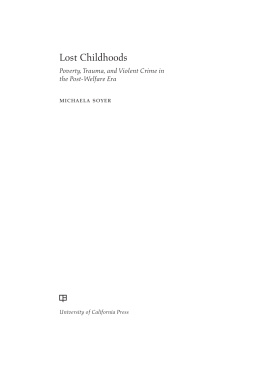Poverty, Ethnicity, and Violent Crime
Crime & Society
Series Editor John Hagan
University of Toronto
Editorial Advisory Board
John Braithwaite, Robert J. Bursik, Kathleen Daly, Malcolm M. Feeley, Jack Katz, Martha A. Myers, Robert J. Sampson, and Wesley G. Skogan
Poverty, Ethnicity, and Violent Crime, James F. Short, Jr.
Great Pretenders: Pursuits and Careers of Persistent Thieves, Neal Shover
Crime and Public Policy: Putting Theory to Work , edited by Hugh D. Barlow
Control Balance: Toward a General Theory of Deviance, Charles R. Tittle
Rape and Society: Readings on the Problems of Sexual Assault, edited by Patricia Searles and Ronald J. Berger
Alternatives to Imprisonment: Intentions and Reality, Ulla V. Bondeson
Inequality, Crime, and Social Control, edited by George S. Bridges and Martha A. Myers
Poverty, Ethnicity, and Violent Crime
James F. Short , Jr.
Crime & Society
First published 1997 by Westview Press
Published 2018 by Routledge
711 Third Avenue, New York, NY 10017, USA
2 Park Square, Milton Park, Abingdon, Oxon OX14 4RN
Routledge is an imprint of the Taylor & Francis Group, an informa business
Copyright 1997 Taylor & Francis
All rights reserved. No part of this book may be reprinted or reproduced or utilised in any form or by any electronic, mechanical, or other means, now known or hereafter invented, including photocopying and recording, or in any information storage or retrieval system, without permission in writing from the publishers.
Notice:
Product or corporate names may be trademarks or registered trademarks, and are used only for identification and explanation without intent to infringe.
Library of Congress Cataloging-in-Publication Data
Short, Jr., James F.
Poverty, ethnicity, and violent crime / James F. Short, Jr.
p. cm.(Crime & society)
Includes bibliographical references and index.
ISBN 0-8133-2013-5 (hardcover).ISBN 0-8133-2014-3 (paperback)
1. Violent crimesUnited States. 2. PoorUnited States.
3. EthnicityUnited States. 4. Social problemsUnited States.
5. United StatesSocial conditions. I. Title. II. Series: Crime
& society (Boulder, Colo.)
HV6789.S524 1997
364.256dc21 97-507
CIP
Typeset by Letra Libre
ISBN 13: 978-0-8133-2014-4 (pbk)
I cannot imagine a more appropriate person than James Short to write about poverty, ethnicity, and violent crime in America. Short brings to this topic a vast experience that ranges from his field research in minority neighborhoods of Chicago through a scholarly career distinguished by major theoretical and methodological innovations to public service on high profile government commissions and panels on violence and crime. Throughout, Jim Short has earned a distinguished reputation for the balance of reason and insight that he brings to controversial social problems, a reputation that has seen him honored, for example, by election to the presidencies of the American Sociological Association and the American Society of Criminology. His contribution on the topic of this volume is especially timely.
As Short demonstrates in an encyclopedic review of the research literature, the contemporary United States is a dangerously violent place, and individuals and families in impoverished minority communities are especially vulnerable to the resulting mayhem. Short squarely confronts these interconnected problems, emphasizing that the association of violent crime with young males in the African-American ghettoes of this nation involves an array of problems, not the least of which is the fear and suspicion created in the minds of more affluent Americans.
Too few citizens are today able to get past their fears and suspicions of minority youth to confront the more daunting realization that changes in the social and economic structure of the United States are responsible for strong connections between race, poverty, and violence. These forces of social and economic change have devastated families and communities that are the foundation of the life chances of growing numbers of American minority youth. Short documents these changes through a comprehensive and insightful mix of quantitative and qualitative, micro-and macro-level data on poverty, ethnicity, and violent crime.
This analysis includes a cautious, yet compelling call to action on the part of American social science, warning that social policy will be made with or without the input of researchers and observing that given this choice, citizens are surely better served by scholars who are willing to join the policy fray The logic of this charge is strikingly supported by Short's assessment of our recent national reliance on imprisonment. The bottom line to this assessment is that we are spending more on prison construction, administration, and on maintaining prison populations than on the types of social policies that scientific research and theory convincingly urge we need.
This book reasonably argues that dispassionate research provides better leads to crime control than do the more impassioned political appeals to public fear and suspicion. This research teaches, for example, that early education and family support are among the most promising tools for effective delinquency and violence prevention. The strong recommendation is that we need to invest more of our resources in building "social capital" through community institutions that support families such as schools, churches, neighborhood centers, and recreational programs. The tragedy is that we are investing less in these institutions, whereas we are placing a level of trust in prisons that no known research literature can sustain.
Characteristically, Short does not in the end recommend placing all of our hopes on any single program or policy. A shrewd believer in hedging our theoretical and practical bets, Short instead urges that we promote a range of programs that address a variety of needs. He counsels further that private as well as public initiatives are required. This book is in the end a powerful argument for the redirection of American crime policy, built on a clearheaded and painstaking integration of theory and research that is the hallmark of the unique reputation and accomplishments of its author. This book can well serve as every student's, scholar's, citizen's, and politician's guide to the causes and prevention of criminal violence in America.
John Hagan
This book began as an essay prepared for the Panel on Understanding and Control of Violent Behavior, a group assembled by the Committee on Law and Justice, one of several committees of the National Research Council's Commission on Behavioral and Social Sciences and Education (CBASSE) (see Reiss and Roth 1993). However, the book's roots go back at least another quarter of a century to the National Commission on the Causes and Prevention of Violence, appointed by President Lyndon B. Johnson following the assassinations of Martin Luther King and Robert E Kennedy I served that commission as co-director of research (with Marvin E. Wolfgang) (see Short 1976).
In still another sense the book is a product of a lifetime of training, research, and experience. Violent behavior has been a personal preoccupation for most of my adult life, including the time before I entered graduate school at the University of Chicago in 1947.







